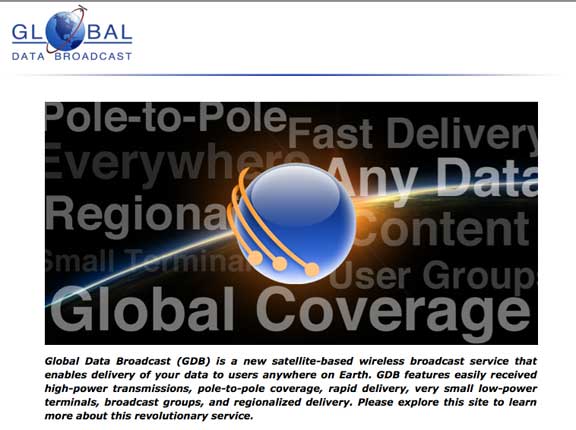An interesting new twist has the potential to ignite innovation. This twist comes in the form of Global Data Broadcast (GDB), a service that enables delivery of data to users everywhere on Earth via a new satellite-based wireless broadcast capability. GDB features very small low-power mobile terminals, easily received high-power transmissions, pole-to-pole coverage, rapid delivery, broadcast groups, and regionalized delivery. GDB can be used by companies, countries or anyone needing to reach groups of users across the planet. GDB provides a cost efficient alternative to private broadcast networks. GDB's unique combination of features enables new uses that were never before possible, providing a great opportunity for companies to access new markets and revenue streams in innovative ways.
The GDB service provides a powerful capability that allows applications ready and affordable access to global and regional coverage areas. Uses for GDB include continuous services such as weather, traffic, social media, official notifications and announcements; globally distributed private user groups; national, state, and local governments for communications across large areas; and customer service and updates to remote users. The potential of GDB is only limited by imagination.
GDB is being developed by Celestech, Inc. in partnership with a major global satellite service provider. Testing of the service is ongoing and it will be commercially available in early 2013. The terminal equipment for GDB consists of a small module weighing about an ounce paired with an equally small antenna. This terminal can be embedded in a wide range of devices depending upon the intended use. The terminals can be mobile—airplanes, vehicles, people —or fixed in a single location. The GDB signal is very strong making it available nearly everywhere outside as well as inside many structures. GDB terminals can also provide time information to the users without having to have a separate clock or navigation receiver.
GDB broadcasters send data using broadcast service groups that they define. GDB Terminals can subscribe to a single service group or dozens of groups as defined by the service broadcasters. GDB service is provided to regions determined by the broadcaster. Any terminal in the region will receive information sent to the groups to which it belongs. GDB also allows broadcasters to send regional content to the same group of users. A broadcaster can change languages or information content for different geographic regions, making the message received by each user specific to its location without having to know where any individual user is located.
GDB is designed to support timely delivery. Messages can be delivered in seconds, or queued for delivery at specific times. A single GDB message can be up to 10 Megabytes in size. The typical user will send messages that are only a few bytes to a few Kilobytes. Short messages (100 bytes or less) are delivered very quickly. Larger messages take proportionally longer to deliver.


